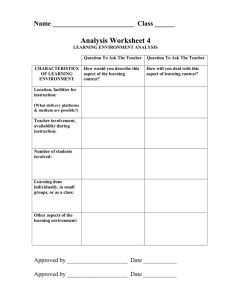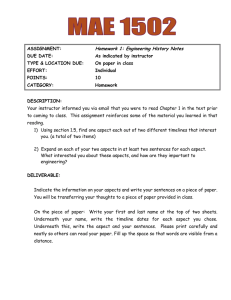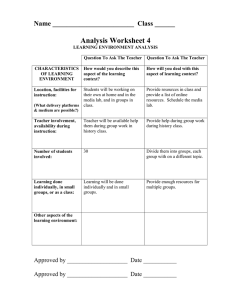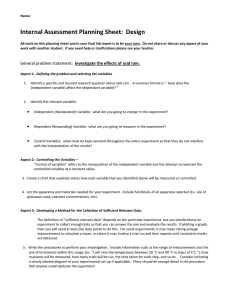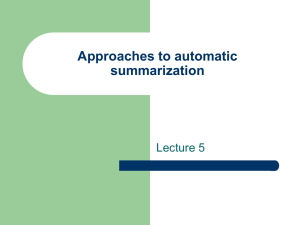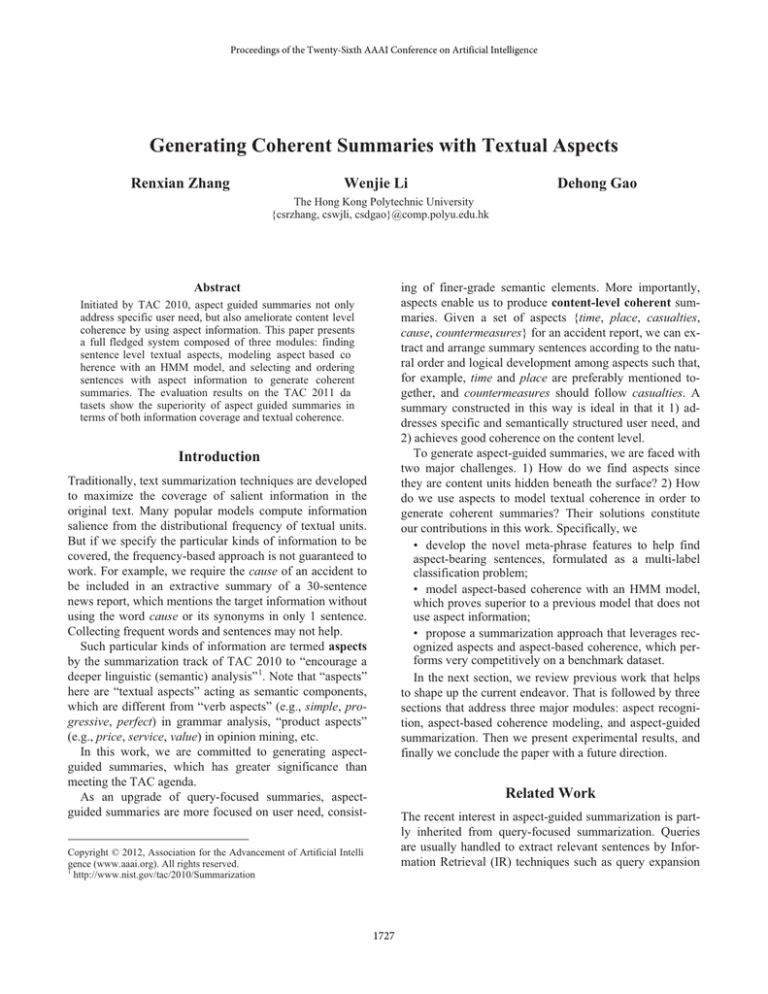
Proceedings of the Twenty-Sixth AAAI Conference on Artificial Intelligence
Generating Coherent Summaries with Textual Aspects
Renxian Zhang
Wenjie Li
Dehong Gao
The Hong Kong Polytechnic University
{csrzhang, cswjli, csdgao}@comp.polyu.edu.hk
ing of finer-grade semantic elements. More importantly,
aspects enable us to produce content-level coherent summaries. Given a set of aspects {time, place, casualties,
cause, countermeasures} for an accident report, we can extract and arrange summary sentences according to the natural order and logical development among aspects such that,
for example, time and place are preferably mentioned together, and countermeasures should follow casualties. A
summary constructed in this way is ideal in that it 1) addresses specific and semantically structured user need, and
2) achieves good coherence on the content level.
To generate aspect-guided summaries, we are faced with
two major challenges. 1) How do we find aspects since
they are content units hidden beneath the surface? 2) How
do we use aspects to model textual coherence in order to
generate coherent summaries? Their solutions constitute
our contributions in this work. Specifically, we
• develop the novel meta-phrase features to help find
aspect-bearing sentences, formulated as a multi-label
classification problem;
• model aspect-based coherence with an HMM model,
which proves superior to a previous model that does not
use aspect information;
• propose a summarization approach that leverages recognized aspects and aspect-based coherence, which performs very competitively on a benchmark dataset.
In the next section, we review previous work that helps
to shape up the current endeavor. That is followed by three
sections that address three major modules: aspect recognition, aspect-based coherence modeling, and aspect-guided
summarization. Then we present experimental results, and
finally we conclude the paper with a future direction.
Abstract
Initiated by TAC 2010, aspect guided summaries not only
address specific user need, but also ameliorate content level
coherence by using aspect information. This paper presents
a full fledged system composed of three modules: finding
sentence level textual aspects, modeling aspect based co
herence with an HMM model, and selecting and ordering
sentences with aspect information to generate coherent
summaries. The evaluation results on the TAC 2011 da
tasets show the superiority of aspect guided summaries in
terms of both information coverage and textual coherence.
Introduction
Traditionally, text summarization techniques are developed
to maximize the coverage of salient information in the
original text. Many popular models compute information
salience from the distributional frequency of textual units.
But if we specify the particular kinds of information to be
covered, the frequency-based approach is not guaranteed to
work. For example, we require the cause of an accident to
be included in an extractive summary of a 30-sentence
news report, which mentions the target information without
using the word cause or its synonyms in only 1 sentence.
Collecting frequent words and sentences may not help.
Such particular kinds of information are termed aspects
by the summarization track of TAC 2010 to “encourage a
deeper linguistic (semantic) analysis” 1. Note that “aspects”
here are “textual aspects” acting as semantic components,
which are different from “verb aspects” (e.g., simple, progressive, perfect) in grammar analysis, “product aspects”
(e.g., price, service, value) in opinion mining, etc.
In this work, we are committed to generating aspectguided summaries, which has greater significance than
meeting the TAC agenda.
As an upgrade of query-focused summaries, aspectguided summaries are more focused on user need, consist-
Related Work
The recent interest in aspect-guided summarization is partly inherited from query-focused summarization. Queries
are usually handled to extract relevant sentences by Information Retrieval (IR) techniques such as query expansion
Copyright © 2012, Association for the Advancement of Artificial Intelli
gence (www.aaai.org). All rights reserved.
1
http://www.nist.gov/tac/2010/Summarization
1727
noun modifier). A predicate can be a verb, noun, or adjective and an argument is a noun. The combination of syntactic tags and/or words gives rise to meta-phrases of the syntactico-semantic pattern, including the predicateargument pattern and the argument-modifier pattern. Table
1 has examples.
NE types represent the semantic attributes of special
NPs in a sentence, which are indicative of particular aspects. We use NE types such as person (/PER/) and organization (/ORG/). The combination of NE type and/or NE
word/phrase gives rise to meta-phrases of the nameneighbor pattern, including the left neighbor-name pattern and the name-right neighbor pattern. Examples are
provided in Table 1.
(Li et al. 2006; Vanderwende et al. 2007) built into statistical (Daumé and Marcu 2006), graph-based (Wan et al.
2007), and learning-based (Fuentes et al. 2007; Schilder
and Kondadadi 2008) models. The state of the art from this
camp, however, does not fit the nature of aspects as particular kinds of information that a summary should include.
Li et al. (2011) apply an unsupervised and topic modelbased approach to aspect-guided summarization. The major limitations are that each sentence is assumed to have a
specific aspect (many TAC document sentences do not)
and that the aspects identified by sentence clustering do not
necessarily match the actually expected aspects.
In contrast, Information Extraction (IE)-based summarization is a better match for aspects. Teufel and Moens
(2002) summarize scientific articles by extracting sentences of certain “rhetorical statuses” – domain-specific aspects.
Ji et al. (2011) propose to find facts about entities, events,
and relations to generate query-focused summaries. We
complement their work with new evidences from aspectguided news summarization.
We find aspects on the sentence level, a sentence classification problem. Related works focus on domain-specific
sentence classes, such as Background, Topic/Aboutness,
etc. for science research papers (Teufel and Moens 1999),
Introduction, Method, etc. for medical abstracts (McKnight
and Srinivasan 2003), and Bio, Fact, etc. for biographies
(Zhou et al. 2004). But we are not aware of prior works
dedicated to sentence-level news aspect classification.
Recently, coherence in summaries draws much attention,
with much effort to model its local (Barzilay and Lapata
2008) and global features (Barzilay and Lee 2004) and
their combination (Elsner et al. 2007). Our modeling of aspect-based coherence improves on the framework in (Barzilay and Lee 2004), which models sentences as observed
sequences emitted from hidden content topics. A crucial
difference between our model and theirs is the use of aspects as an intermediary between sentence and words.
Syntactico
semantic
patterns
Name
neighbor
patterns
Predicate argument
Argument modifier
Left neighbor name
Name right neighbor
linked fen phen Æ
(/PRED/, /dobj/)
Clinic study Æ (/nn/,
/ARG/)
a Mayo Clinic Æ (‘a’,
/ORG/)
Mayo Clinic study Æ
(/ORG/, ‘study’)
Table 1: Meta-phrase patterns and examples
In the above, we have only shown one of the extractable
meta-phrases from tag/word combinations. For syntacticosemantic patterns, two related words and their syntactic
tags give a total of 4 combinations. For example,
(/PRED/, /dobj/)
linked fen-phen
(/PRED/, ‘fen-phen’)
(‘linked’, /dobj/)
(‘linked’, ‘fen-phen’)
For name-neighbor patterns, an NE or its type alone
(with the /NULL/ tag) or with its left/right neighbor gives 4
combinations as shown below.
(/ORG/, ‘study’)
Mayo Clinic study
(/ORG/, /NULL/)
(‘Mayo Clinic’, ‘study’)
(‘Mayo Clinic’, /NULL/)
Such syntactico-semantic and name-neighbor metaphrases are designed to capture syntactic relations and NE
contexts at different levels of abstraction.
Name-neighbor meta-phrase extraction relies on NE
recognition; syntactico-semantic meta-phrases are extracted in three scans via dependency parsing: 1) Scan for all
predicate-argument pairs in the sentence from dependency
relations: nominal subject, direct object, agent, etc.; 2)
Scan for all nominal argument modifiers from dependency
relations: noun modifier, appositional modifier, etc.; 3)
Scan for all adjectival argument modifiers from the dependency relation of adjectival modifier.
Aspect Recognition
In this section, we explain how aspects are found on the
sentence level – appropriate for extractive summarization.
Feature Extraction
Since aspects may be hidden under the literal content, we
devise a new type of features: meta-phrase features.
We define a meta-phrase as a 2-tuple (m1, m2) where mi
is a word/phrase or word/phrase category, which is a syntactic tag, a named entity (NE) type, or the special
/NULL/ tag. Syntactic tags represent the logical and syntactic attributes of words in a sentence, including logical
constituents (/PRED/ for predicate, /ARG/ for argument)
and grammatical roles (e.g., /dobj/ for direct objet, /nn/ for
Multi-label Classification
One sentence may be associated with multiple aspects, so
aspect recognition on the sentence level is a multi-label
classification problem.
1728
Label combination and binary decompositions (Boutell
et al., 2004; Tsoumakas and Katakis, 2007) can be used to
transform multi-label classification to single-label classifications. The former maps the original k label sets to the 2k
label power sets by transforming all distinct label subsets
into single label representations. The latter transforms the
original k-label classification into k single-label classifications before aggregating the k classification results to obtain the final result.
A potential problem with label combination (LC) is that
there may not be sufficient training data available for each
transformed single-label class, whereas binary decomposition (BD) assumes label independence which does not necessarily hold. In the “Experiments” section, we will show
that BD performs better for our task.
Figure 1: Models without (left) and with (right) aspects
Topic Induction
In our model, the topics are represented by sentence clusters. Like (Barzilay and Lee 2004), we use complete-link
hierarchical clustering to cluster sentences. But unlike their
work, we vectorize sentences using both words and aspects.
The aspects are twice as much weighted as the words,
which corresponds to the aspect’s conceptual significance
and leads to better clustering quality 2.
Among the clusters, one is merged from all smaller clusters (cluster size < M) that possibly contain non-essential
information. We denote this merged cluster as c0.
Semi-supervised Learning
We observe that for this task, classification accuracy may
suffer from insufficient training data and a model learned
from limited training data may not adapt well to unseen data. For example, in the TAC data used in our experiments,
“health and safety” articles can range from Chinese food
safety to protective helmets in the United States.
A promising answer to those issues lies in transductive
SVM (Vapnik, 1998; Joachim, 1999), which predicts test
labels by using the knowledge about test data. So it addresses both training (labeled) data deficiency and model
adaptability. Unlike the standard or inductive SVM, transductive SVM is formulated to find an optimal hyperplane
to maximize the soft margin between positive and negative
objects as well as between training and test data. It has also
been theoretically proved that if properly tuned, transductive SVM generally performs no worse than its inductive
counterpart (Wang et al. 2007).
For those reasons, we will use transductive SVM as the
classifier. In the “Experiments” section, we will show how
transductive SVM compares with inductive SVM.
HMM Parameter Estimation
Given topics c0, c1, … with their corresponding HMM
states s0, s1, …, we now estimate the HMM parameters.
With no prior knowledge about the topics, we assume uniform distribution for the state probabilities. We denote
aspects as ai’s and words as wi’s. Given a sentence
x w1 w2 ...wn having aspects: {a1 ,..., am } and state s (s s0),
the emission probability P(x|s), shorthanded Ps(x), is:
Ps ( x)
¦
m
i 1
(1)
Ps ( x | ai ) Ps (ai )
For aspect a A , the set of all aspects, MLE is used to
estimate the raw probability of Ps *(a ) : (s s0)
Ps * (a )
(Countc (a ) G1 ) / (¦ a ' Countc (a ') G1 | A |)
where Countc (a ) is the count of a in cluster c (corresponding to s) and 1 is a smoothing coefficient. Note that some
sentences may not have aspects and in this case, we use a
special a0 to represent the “empty aspect” and: (s s0)
Ps *(a0 )
Aspect-based Coherence Modeling
| A|
i 1
(1 Ps *(ai ))
The raw probabilities are normalized so that they sum up
to 1: (s s0) Ps (a ) P *s (a ) / ¦ a ' P *s (a ')
After aspects are recognized for each sentence, we then
model text coherence from a topical perspective. Topics
are organizational units that a human writer chooses and
arranges to deliver a coherent train of thought. Modeling
coherence thus hinges on modeling topic formation and
transitions. We follow (Barzilay and Lee 2004) by using an
HMM model with topics as states and sentences as observed sequences. But unlike their model that represents
topics on the word level, we use aspects as semantic components of a topic, about which specific words are chosen.
Figure 1 illustrates the difference between their model and
ours with sentence generation mediated by aspects. The introduction of aspects contributes to a more intuitive modeling of the human writing process.
For Ps0 (a ) , we make it complementary to the other
Ps(a)’s, as in (Barzilay and Lee 2004):
Ps0 (a ) (1 Maxs 'z s0 Ps ' (a )) / ¦ a 'A{a } (1 Maxs 'z s0 Ps ' (a '))
0
Ps(x|a) in (1) can be estimated by taking the aspectconditioned word generation and a bigram language model:
Ps ( x | a )
2
Ps ( w1... wn | a ) | i 1 ( Ps ( wi | a ) Ps ( wi | wi 1 ))
n
We evaluated different sentence vectorizing schemes using the Silhou
ette (Rousseeuw 1987) and Rand (Rand 1971) measures.
1729
(Countc ( w(a )) G 2 ) / (Countc (a ) G 2 | V |)
Ps ( w | a )
coherent sentence ordering by selecting among all possible
permutations one with the highest likelihood, computed by
the forward algorithm.
where Countc ( w(a )) | {a ' : w s s a ' a ' c} | , s s0,
and V is the vocabulary. For Ps0 ( w | a ) ,
Ps0 ( w | a )
(1 Maxs 'z s0 Ps ' ( w | a)) / ¦ w 'V (1 Maxs 'z s0 Ps ' ( w ' | a '))
We use the Bayesian rule for a0:
Ps * ( w | a0 ) Ps ( w) P(a0 | w) / Ps (a0 )
To do extractive summarization, we build an aspect-guided
summarizer following the pipeline of sentence selection
and sentence ordering. Aspect information plays a significant role in both steps.
p
Ps ( w | ai ) P(ai )
) / Ps (a0 )
Ps ( w)
i 1
and after normalization,
Ps ( w | a0 ) P *s ( w | a0 ) / ¦ w ' P *s ( w ' | a0 )
Ps ( w) (1 (2)
Sentence Selection with a Base Summarizer
We first describe an aspect-agnostic summarizer using a
simple method (Zhang et al. 2011). The following formula
is used to calculate the frequency score of a sentence s in
document set D.
¦ ws TFs (w) score(w)
(3)
freq score( s )
¦ ws TFs (w) ISF (w)
To calculate Ps(w) in (2), for s s0,
Ps ( w) (Countc ( w) G 3 ) / (¦ w 'V Countc ( w ') G 3 | V |)
Ps0 ( w)
(1 Maxs 'z s0 Ps ' ( w)) / ¦ w 'V (1 Maxs 'z s0 Ps ' ( w '))
The estimation of Ps(w|w’) is as in (Barzilay and Lee
2004) and then we have:
Ps * ( x | a )
n
i 1
( Ps ( wi | a ) Ps ( wi | wi 1 ))
where score( w) log TFD ( w) , and the word w is a frequent
or document topic word (i.e., a word used in the description of a document set); otherwise score(w) = 0. ISF(w) is
the inverted sentence frequency of w in the document set,
defined as ISF ( w) log( N s / SFD ( w)) . TFs(w) and TFD(w)
are the frequencies of w in s and D; SFD(w) is the sentence
frequency of w in D and Ns is the total number of sentences
in D. The ISF-based sentence length is used to discount
important words less.
Summary sentences are selected iteratively until summary length is reached. In each iteration, we select the top
ranking sentence s* and then discount the frequency of all
the words in s* by multiplying < 1. Redundant sentences
are dropped using cosine similarity.
After normalization,
Ps ( x | a ) P *s ( x | a ) / ¦ x ' P *s ( x ' | a )
The state transition probabilities are estimated from
two sources: sentences (Psent(sj|si)) and aspects (Paspect(sj|si)).
Psent ( s j | si ) ( SC (ci , c j ) G 4 ) / ( SC (ci ) G 4 r )
Paspect ( s j | si )
Aspect-guided Summarization
( AC (ci , c j ) G 5 ) / (¦ j 1 AC (ci , c j ) G 5 r )
r
where r is the total number of topics (states), SC(c, c’) represents the count of documents where a sentence from c
immediately precedes a sentence from c’, SC(c) represents
the total count of documents with sentences from c. AC(c,
c’) represents the count of documents where a sentence
from c contains an aspect that immediately precedes an aspect contained in a sentence from c’. Aspect precedence is
estimated by aspect-bearing sentence precedence.
We estimate the sentence-based state transitions and the
aspect-based state transitions differently because unlike
sentences, aspects are not unique in a document. The final
transition probability is a linear combination of them:
P ( s j | si ) O1 Psent ( s j | si ) (1 O1 ) Paspect ( s j | si )
Sentence Selection with Recognized Aspects
Next we integrate the recognized sentential aspect information into the base summarizer.
For a sentence s, we first calculate its aspect score:
aspect score s ¦ asps classify score(asp ) ,
where classify score(asp) indicates the classification confidence for aspect asp. For our current scheme, it is the
value calculated by the decision function trained from
transductive SVM.
The final score of a sentence is a linear combination of
its frequency score and aspect score.
score( s ) O2 u freq score( s ) (1 O2 ) u aspect score( s )
where 2 is a coefficient in 0 .. 1. The iterative sentence selection algorithm is similar to that described for the base
summarizer. The main difference is that after each iteration,
not only the word scores but also the aspect scores are updated. For all the aspects in a selected sentence s*,
classify score(asp ) E classify score(asp ) , < 1.
where 1 is a coefficient in 0 .. 1.
Parameter Re-estimation and Coherent Ordering
Determination
The original sentence clustering does not account for sentence order information in the training data. To utilize this
important information for sentence ordering, we re-cluster
the sentences by assigning each one to the topic (state) that
most likely emits it, determined by Viterbi decoding. Then
the HMM parameters are re-estimated and we iterate the
process until clusters converge (Barzilay and Lee 2004).
With a learned HMM model, we can determine the most
1730
OpenNLP tools 4 to find named entities for name-neighbor
features. Features that occur only once are filtered. The inductive and transductive SVM classifications are implemented by using the SVMlight tool 5 with a linear kernel.
Sentence Ordering for Aspect-based Coherence
After we select all the sentences that meet the summary
length requirement, we order them by considering all possible sentence permutations. Since aspect-guided summaries and source documents obviously differ in aspect density
and content structure, we train an HMM model with aspect-annotated human summaries for similar documents.
Then we select the best ordering among all sentence permutations as the sequence with the highest likelihood according to the HMM model parameters. This straightforward approach integrates well into the selection-ordering
scheme. In the next section, we will show the efficacy of
our simple method, especially for coherence enhancement.
We should also point out that for multi-document summarization, the summarization strategy in (Barzilay and
Lee 2004), which attempts to correlate summary sentences
with source sentences, cannot be adopted because it only
works for single-document summarization. It is also pointless to train an HMM model with sentences simultaneously
from different documents.
Results
For limit of space, we show the result only on one category
(D3) in Figure 2, using different features. The results on
the other categories are similar. The classifier is inductive
SVM and we report the ten-fold cross validated Fmeasures on each aspect.
Figure 2: Using different features on health and safety
In most cases, the meta-phrase features help to improve
classification performance, especially on aspects that may
not be literally expressed (e.g., D3.3, D3.4, D3.5).
To test the multi-label classification and semi-supervised
scheme, for each category we randomly select a small
training set of 100 sentences as labeled data and 1500 different sentences as unlabeled data. Both word and metaphrase features are used.
We compare both multi-class transformations (BD vs.
LC) and classification algorithms (inductive SVM vs.
transductive SVM). The evaluation metric is macroaverage F measure, i.e., the average of F-measures on individual aspects. Figure 3 shows the aggregate result.
Experiments
We evaluate our method on three tasks: aspect recognition,
text ordering, and summarization.
Evaluating Aspect Recognition
Our experimental data are composed of TAC 2010 source
documents. For each of the documents of a category (accidents, attacks, health and safety, resources, investigations),
we annotated a predefined list of aspects 3 for each sentence.
Each of the 5 categories contains approximately 2000 sentences, from with 90% are used for training and the rest for
test. Table 2 lists the aspects of category D3 (health and
safety) and its aspects with brief explanations, followed by
a sample annotated sentence.
D3.1 WHAT
D3.2 WHO AFFECTED
D3.3 HOW
D3.4 WHY
D3.5 COUNTERMEASURES
what is the issue
who is affected
how they are affected
why the issue occurs
countermeasures
Table 2: Aspects for Category D3 (health and safety)
The drugs were withdrawn in September 1997 after a
Mayo Clinic study linked fen-phen to potentially fatal heart
valve damage. {D3.1, D3.3, D3.5}
Implementation Details
Figure 3: Macro-average F on the five categories
Transductive SVM defeats inductive SVM with an obvious
advantage, showing the feasibility of semi-supervised
To extract meta-phrase features, we use the Stanford Parser
(Klein and Manning 2003) to do dependency parsing and
extract all syntactico-semantic features. We use the
3
4
See http://www.nist.gov/tac/2010/Summarization for details about the 5
categories and a total of 30 aspects.
5
1731
http://opennlp.sourceforge.net/
http://svmlight.joachims.org/
learning for our task. In most cases, binary decomposition
is superior to label combination.
model trained from all the TAC 2010 human summaries to
order sentences selected for summary. All the model details and parameters are derived from the previous experiments on aspect recognition and text ordering.
Evaluating Text Ordering
Barzilay and Lee (2004) have shown the superiority of the
HMM model in ordering to a baseline bigram model and a
different probabilistic ordering model (Lapata 2003). Due
to limit of space, we report how our aspect-based HMM
model compares with their aspect-agnostic model.
Results
Information coverage is evaluated by the standard ROUGE
measures (Lin and Hovy 2003). In Table 3, “Top” is the
top ranking participant in TAC 2011 and “Average” is the
average over all 50 TAC participants. Note that it is unnecessary to compare sentence orderings here because
ROUGE is ordering-insensitive.
Implementation Details
To evaluate the HMM model on summary text ordering,
we annotated all the TAC 2010 human summaries for
training (80%) and development (20%) data, with an average of 36.8 documents per category. We also annotated all
the TAC 2011 human summaries for test, with an average
of 35.2 documents per category 6. We tune the HMM model
parameters (M, 1 to 5, and 1) on the development data, as
well as the number of topics (states).
Base Summarizer
Base Summarizer + Aspect
Top
Average
ROUGE 2
0.1206
0.1223
0.1337
0.0932
ROUGE SU4
0.1570
0.1581
0.1636
0.1266
Table 3: ROUGE evaluations of summaries
The base summarizer is a very competitive system (TAC
ID: 4) in TAC 2011, ranking 5th and 4th in terms of
ROUGE-2 and ROUGE-SU4, but it is outperformed by its
aspect-enhanced version (TAC ID: 24) ranking 4th and 3rd
in terms of ROUGE-2 and ROUGE-SU4. We observe that
using recognized aspects helps to include more desirable
information in summaries. But the improvement is limited,
partly because the base summarizer has already included
many aspects that happen to contain many frequent words.
To test the use of aspect in enhancing coherence, we
employ two human judges to rate the coherence of summaries on a scale of 5 points, the higher the more coherent.
For each TAC document set, we ask them to rate 4 summaries: 3 automatic summaries produced by the aspectenhanced summarizer and 1 human summary. The automatic summaries differ from each other only in sentence
ordering: following the selection sequence determined by
sentence ranking scores (Ranking ordering), using the
HMM model without aspect, i.e., Barzilay and Lee’s (2004)
model (BL ordering), using the HMM model with aspect
(Aspect ordering). Cohen’s Kappa is computed to be 0.71,
indicating high inter-judge agreement. Table 4 lists the result, with the scores averaged over two judges.
Results
Figure 4 shows the difference between using aspect information and only literal information (NoAspect), measured
by Kendall’s , a widely used sequence ordering measure
(Lapata 2006).
Figure 4: Ordering with and without aspects
Augmented with aspect information, the HMM model is
shown to better represent the pattern of coherent ordering.
Ranking
ordering
2.75
Evaluating Summarization
We evaluate the proposed summarization method on the
TAC 2011 datasets (initial summarization subtask). According to our approach, aspect information is used in two
stages: selecting sentences to cover particular information
and ordering the selected sentences to enhance coherence.
We use the classification model trained from all the TAC
2010 source documents to recognize aspects and the HMM
BL ordering
3.45
Aspect
ordering
3.73
Human
4.70
Table 4: Human Evaluation for Coherence
The differences between the two HMM ordering versions and the “Ranking ordering” or “Human” are very
significant (p < 0.0001 on a paired two-tailed t-test). The
difference between BL ordering and Aspect ordering is also significant (p = 0.017), though to a lesser degree. The
3.73 point by “Aspect ordering” proves that aspect-based
ordering helps to generate fairly coherent summaries.
6
We use only the initial summaries. There are 46 document sets for TAC
2010 and 44 for TAC 2011, each with 4 human summaries.
1732
Lapata, M. 2006. Automatic evaluation of information ordering:
Kendall’s tau. Computational Linguistics, 32(4):1 14.
Li, P., Wang, Y., Gao, W., and Jiang, J. 2011. Generating Aspect
oriented Multi Document Summarization with Event aspect
Model. In Proceedings of the 2011 Conference on Empirical
Methods in Natural Language Processing, 1137 1146. Edinburgh,
Scotland, UK.
Li, W, Li, W, and Lu, Q. 2006. “Mining Implicit Entities in Que
ries”. In Proceedings of the 5th International Conference on
Language Resources and Evaluation (LREC'06), 24 26. Genoa,
Italy.
Lin, C Y. and Hovy, E. 2003. Automatic Evaluation of Summar
ies Using N gram Co Occurrence Statistics. In Proceedings of the
Human Technology Conference 2003 (HLT NAACL 2003), 71 78,
Edmonton, Canada.
McKnight, L., and Srinivasan, P. 2003. Categorization of Sen
tence Types in Medical Abstracts. In Proceedings of the Ameri
can Medical Informatics Association Annual Symposium, 440
444, Washington D.C.
Rand, W. M. 1971. Objective Criteria for the Evaluation of Clus
tering Methods. Journal of the American Statistical Association
(American Statistical Association), 66 (336): 846 850.
Rousseeuw, P. J. 1987. Silhouettes: a Graphical Aid to the Inter
pretation and Validation of Cluster Analysis. Computational and
Applied Mathematics 20: 53 65.
Schilder, F. and Kondadadi, R. 2008. FastSum: Fast and Accurate
Query based Multi document Summarization. In Proceedings of
ACL 08: HLT, short papers, 205 208.
Teufel, S. and Moens, M. 1999. Argumentative Classification of
Extracted Sentences as a First Step towards Flexible Abstracting.
In I. Mani and M. T. Maybury (eds.), Advances in Automatic Text
Summarization. 155 171. Cambridge, Massachusetts: MIT Press.
Teufel, S., and Moens, M. 2002. “Summarizing Scientific Arti
cles: Experiments with Relevance and Rhetorical Status”. Com
putational Linguistics, 28(4): 409 445.
Tsoumakas, G. and Katakis, I. 2007. Multi label classification:
An overview. International Journal of Data Warehousing and
Mining, 3(3):1 13.
Vanderwende, L., Suzuki, H., Brockett, C., and Nenkova, A.
2007. “Beyond SumBasic: Task Focused Summarization with
Sentence Simplification and Lexical Expansion”. Information
Processing & Management 43(6):1606 1618.
Vapnik, V. 1998. Statistical Learning Theory. New York: John
Wiley & Sons.
Wan, X., Yang, J., and Xiao, J. 2007. Towards a Unified Ap
proach Based on Affinity Graph to Various Multi document
Summarizations. In Proceedings of the 11th European conference,
297 308.
Wang, L., Shen, X., and Pan, W. 2007. On Transductive Support
Vector Machines. In J. Verducci, X. Shen, and J. Lafferty (eds.),
Prediction and Discovery. American Mathematical Society.
Zhang, R., Ouyang, Y., and Li, W. 2011. Guided Summarization
with Aspect Recognition. In Proceedings of Textual Analysis
Conference (TAC 2011).
Zhou, L., Ticrea, M., and Hovy, E. 2004. Multidocument Biog
raphy Summarization. In Proceedings of Empirical Methods in
Natural Language Processing (EMNLP 04), 434 441.
Conclusion and Future Work
Inspired by the TAC task, we propose a full-fledged approach to aspect-guided summarization. We recognize aspects in sentences with the help of the novel meta-phrase
features and adapt an HMM model to aspect-based coherence. Based on sentence-level aspect information and the
trained coherence model, we propose a simple but successful summarization model that leverage aspects in both sentence selection and ordering.
Our current model treats sentence selection and ordering
as two independent modules. In the future, we will explore
integrating the two modules to fully utilize annotated aspect information.
Acknowledgements
The work described in this paper was supported by the
grant GRF PolyU 5230/08E.
References
Barzilay, R. and Lapata, M. 2008. Modeling Local Coherence:
An Entity Based Approach. Computational Linguistics, 34:1 34.
Barzilay, R., and Lee, L. 2004. Catching the Drift: Probabilistic
Content Models, with Applications to Generation and Summari
zation. In HLT NAACL 2004: Proceedings of the Main Confer
ence. 113 120.
Boutell, M. R., Luo, J., Shen, X., and Brown, C. M. 2004, Learn
ing Multi label Scene Classification, Pattern Recognition,
37(9):1757 71.
Daumé III, H. and Marcu, D. 2006. Bayesian Query Focused
Summarization. In Proceedings of ACL 2006, 305 312, Sydney,
Australia.
Elsner, M., Austerweil, J. & Charniak E. 2007. “A Unified Local
and Global Model for Discourse Coherence”. In Proceedings of
NAACL HLT 2007, 436 443. Rochester, NY.
Fuentes M, Alfonseca E, and Rodríguez H. 2007. Support Vector
Machines for Query focused Summarization Trained and Evalu
ated on Pyramid Data. In Proceedings of the 45th annual meeting
of the association for computational linguistics companion vol
ume proceedings of the demo and poster sessions, 57 60.
Ji, H., Favre, B., Lin, W., Gillick, D., Hakkani Tur, D., and
Grishman, R. 2011. Open domain Multi document Summariza
tion via Information Extraction: Challenges and Prospects. in
Multi source, Multilingual Information Extraction and Summari
sation Volume of "Theory and Applications of Natural Language
Processing". Springer.
Joachims, T. 1999. Transductive Inference for Text Classification
using Support Vector Machines. In Proceedings of the 16th Inter
national Conference on Machine Learning (ICML).
Klein, D., and Manning, C. D. 2003. Accurate Unlexicalized
Parsing. In Proceedings of the 41st Meeting of the Association for
Computational Linguistics, 423 430.
Lapata, M. 2003. Probabilistic Text Structuring: Experiments
with Sentence Ordering. In Proceedings of the Annual Meeting of
ACL, 545 552. Sapporo, Japan.
1733

